Ever tried setting up a game of cornhole only to stop and wonder, “Wait, what’s the right cornhole board distance again?” You’re not alone. It’s one of those small details that can make a big difference, especially when friends or family are ready to play and everyone has a different opinion about how far apart the boards should be. It can feel confusing, and nobody wants to start a fun game with an argument about measurements.
That’s where this guide comes in. In this post, we’ll clear up the exact cornhole board distance you should use, whether you’re playing casually in the backyard, teaching kids, or aiming for official tournament standards. You’ll get simple answers, helpful tips, and the confidence to set things up the right way so you can focus on enjoying the game.
How to Play Cornhole
Cornhole is deceptively simple but surprisingly strategic. The game involves tossing beanbags onto a slanted board with a hole at the far end. Players or teams alternate turns, aiming to land the bags on the board for points or sink them through the hole for maximum points.
Games can be singles (one-on-one) or doubles (teams of two). Each player pitches four bags per frame, walking to the opposite board to score before returning. Understanding spacing between boards is key because even a few feet too close or too far can change the trajectory and difficulty of every toss.
The Basic Rules of How to Play Cornhole
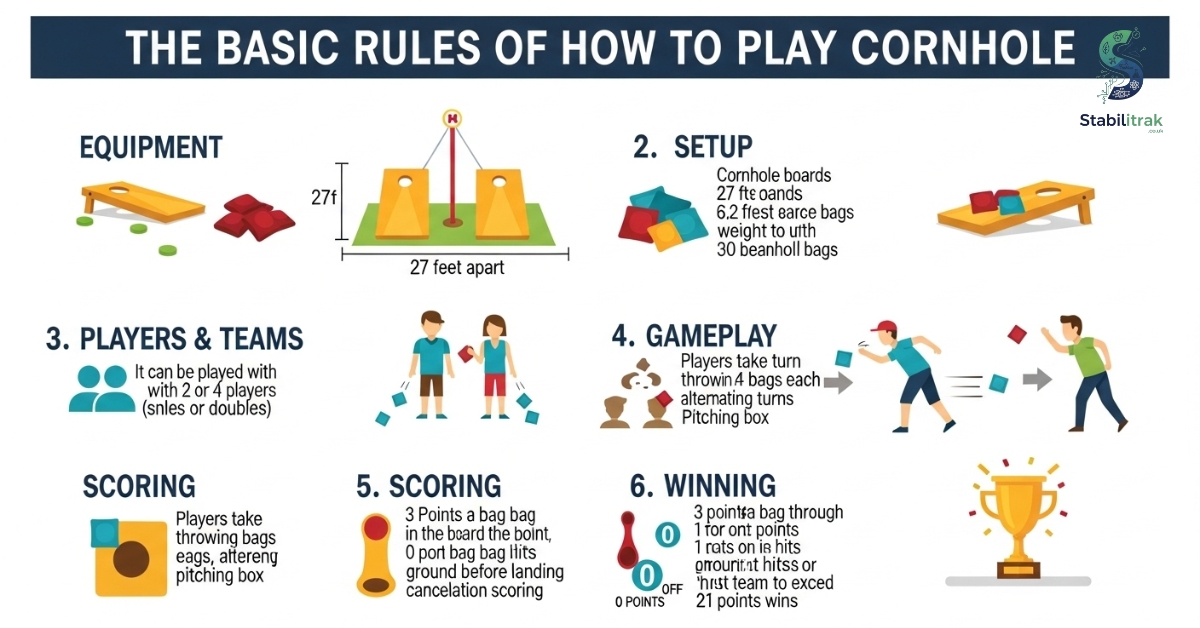
The basic goal is simple: score points by landing your bags on the board (“woody”) or in the hole (“cornhole”). Points are tallied using the cancellation scoring method, where your points cancel out your opponent’s points in each frame.
Each game is typically played to 21 points, but timed matches of 20 minutes are common in tournaments. Knowing the cornhole board distance ensures each player has an equal chance at scoring and makes official rules easier to follow.
Objective
The objective is more than just throwing bags. You’re trying to control the scoring, set up blocks, and strategically aim for your opponent’s board. Proper board spacing gives players a fair challenge and keeps the game consistent for casual and competitive play alike.
Cornhole Equipment
You’ll need regulation cornhole boards, standard beanbags, and a flat surface. Boards usually measure 2×4 feet, with a 6-inch hole centered 9 inches from the top and 12 inches from each side. Bags weigh between 14 and 16 ounces and are filled with plastic pellets.
Professional setups may include cornhole mats, scoreboards, and specialized tools like a carpenter’s square or tape measure to guarantee accurate board spacing. For backyard play, even homemade boards work, but keeping a consistent distance is key to fair play.
Cornhole Board Distance
The cornhole board distance for official adult play is 27 feet from front edge to front edge. This is the standard used in tournaments and recommended by ACA guidelines. Proper spacing ensures that tosses are challenging but manageable for competitive play.
For junior players under 12, or beginners, the boards can be set closer together, between 12 and 15 feet apart. This adjustment lets younger players enjoy the game while still learning aiming and scoring techniques. Casual backyard setups can be flexible, but aim for at least 12 feet to give space for proper tosses.
Cornhole Rules
Players must pitch bags underhand from a designated pitcher’s box measuring 4×3 feet. At least one foot must remain inside the box during the throw. A bag is considered a foul if it lands on the ground before reaching the board or if a player steps past the foul line.
Timing rules include pitching within 15 seconds and scoring frames after all bags have come to rest. Maintaining the proper cornhole board distance keeps these rules effective and makes scoring straightforward.
Cornhole Scoring
Scoring uses the cancellation method: each “woody” counts as 1 point, and each “cornhole” counts as 3 points. Only one team can score per frame after points are canceled.
Players must update scores at the end of each frame and may consult a Certified Official in tournaments if there’s a discrepancy. Accurate board spacing ensures consistent difficulty, keeping scoring fair and competitive.
Winning the Game
Victory usually goes to the first player or team to reach 21 points. In timed matches, the team leading when the clock expires wins. Proper spacing keeps the game challenging and ensures that skill, not luck, decides the winner.
Everything You Need to Know About Cornhole Rules
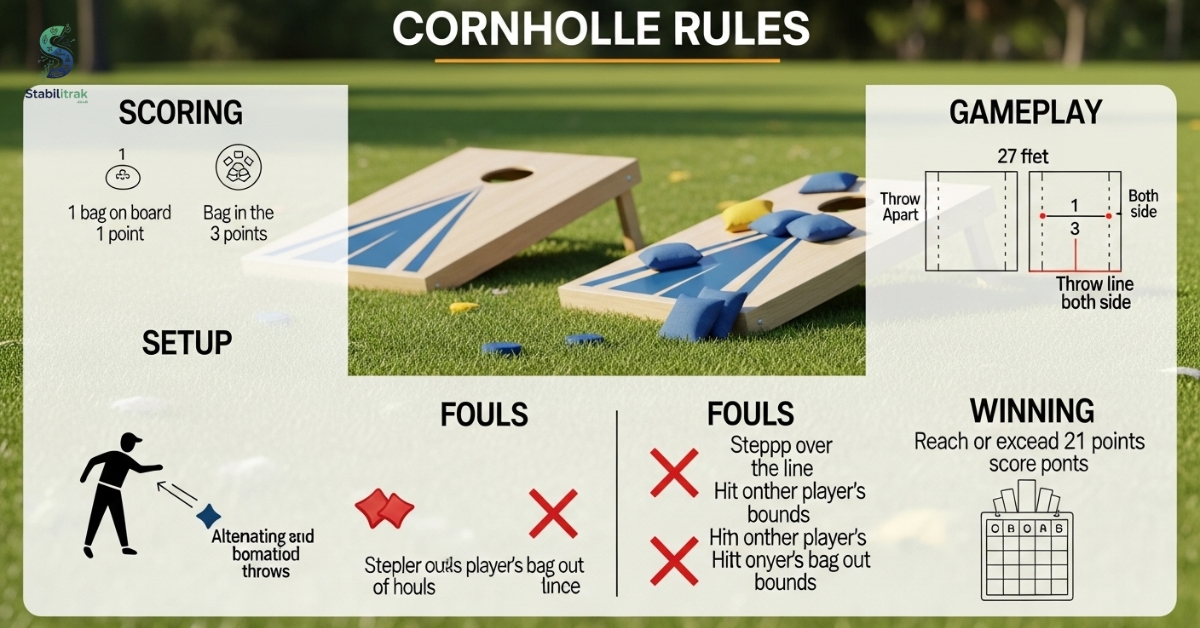
Official rules from the ACA cover board specifications, bag weight, court layout, and pitching rotations. Following these rules makes games uniform, whether you’re hosting a backyard match or participating in a tournament. Accurate cornhole board distance is central to compliance with these guidelines.
How to Play Cornhole | The Court
The regulation court is 40 feet long and 8 feet wide, with 12 feet of vertical clearance. Boards are placed on flat ground, with the front edges exactly 27 feet apart for adult play. The foul line is at the front edge of each board.
Court Layout
The court includes two lanes, one for each player or team, with designated pitcher’s boxes on either side. Proper lane alignment and spacing between boards allow players to move safely and pitch effectively.
Court Dimensions
- Board: 2×4 feet
- Hole: 6 inches
- Top from hole: 9 inches
- Sides from hole: 12 inches
- Front: 3 to 4 inches
- Back: 12 inches
- Court width: 8 to 10 feet
- Court length: 40 to 45 feet
Accurate cornhole board distance ensures these measurements create a fair challenge for all players.
Pitcher’s Box
Each pitcher must stay within the 4×3 feet box. Exiting the box during a pitch is a foul, emphasizing the importance of accurate spacing to avoid collisions and maintain fairness.
Foul Lines
The front edge of the board is the foul line. Players must release bags before crossing them, which is easier to monitor when boards are properly spaced.
Vertical Clearance
A minimum of 12 feet of overhead clearance is recommended, especially indoors, to allow high tosses without interference.
Multiple Courts
When setting up several courts, leave adequate space between each set to prevent interference and keep safety in mind. A 27-foot distance between boards applies to each court, while spacing multiple courts requires extra room for players and spectators.
Read More Article: How Much to Tint Car Windows
How to Play Cornhole | Equipment Standards
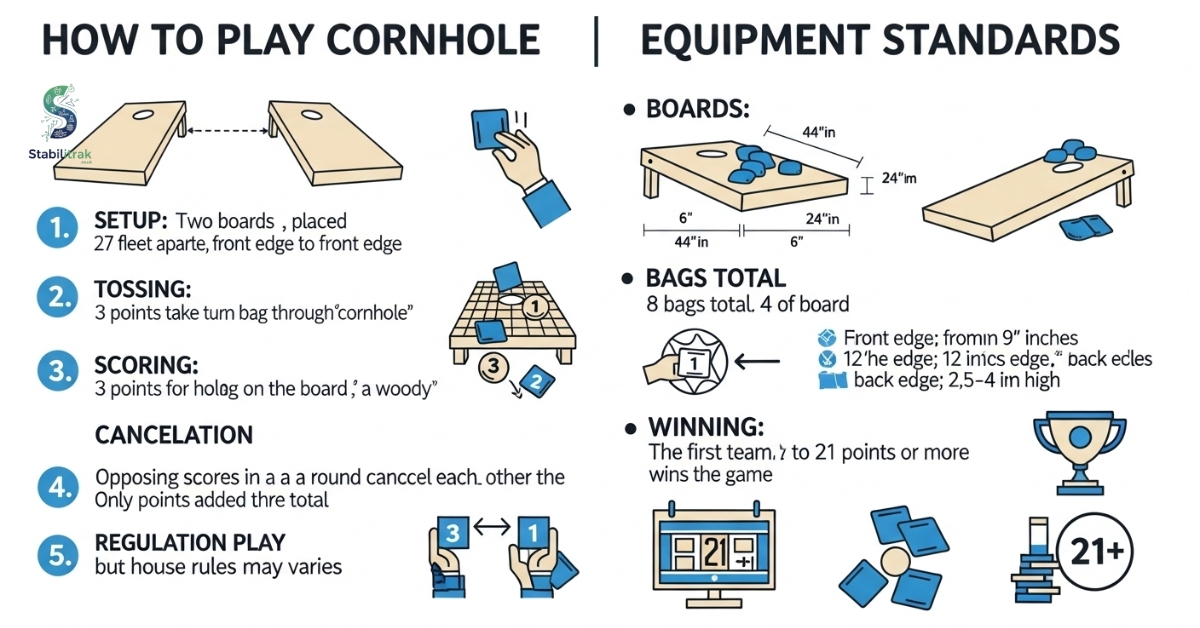
Professional boards use smooth plywood, durable fabric bags, and high-gloss finishes. Some casual setups use inflatable or DIY boards, but even then, following standard cornhole board distance improves gameplay.
Cornhole Boards
Boards should weigh at least 25 pounds and have smooth surfaces for consistent bag slides. For tournaments, certified boards are required.
Cornhole Bags
Bags are 14 to 16 ounces, made from canvas, twill, or synthetic suede, and double-stitched. Proper bag weight ensures consistent flight and scoring.
How to Play Cornhole | Scoring
Frames are scored after all bags settle. Dead or foul bags are removed, and points are tallied using cancellation scoring. Proper cornhole board distance is crucial for maintaining fair scoring conditions.
Pregame Coin Toss
A coin toss decides which player or team pitches first, chooses sides, or chooses bag color. This pregame step ensures fair play, especially on regulation courts.
Play of the Game
Players alternate pitching bags, following turn rotation. Maintaining consistent board spacing helps each player judge distance and accuracy.
Singles Cornhole Matches
One-on-one matches are straightforward, but spacing is critical to keep the toss challenging and fair.
Doubles Cornhole Matches
Two-on-two matches require careful lane assignments. Boards spaced correctly allow both teams to play without obstruction.
Foul Bag Rule Violations
Violations include bags landing on the ground, stepping past foul lines, or pitching out of turn. Correct board distance prevents accidental fouls caused by overcrowding or improper alignment.
Determining Winners – Traditional 21
The first team to reach 21 points wins. Accurate board spacing ensures that skill determines the outcome, not irregular setup.
Setting Up Your Cornhole Boards
- Choose a flat surface free of obstacles.
- Use a tape measure or pacing method to place boards 27 feet apart.
- Ensure pitcher’s boxes are aligned and markings are clear.
- Check for level boards for smooth gameplay.
Importance of Proper Distance
Spacing impacts trajectory, scoring, and fairness. Too close, and bags land easily; too far, and even skilled players struggle. Junior players may start at 12–15 feet for better accessibility.
Tips for Setting Up
- Use a carpenter’s square to align boards.
- Consider lighting for night games.
- Leave space for spectators and seating.
- Keep a scoreboard visible for cancellation scoring.
Fun Variations
- Backyard shorter boards for kids.
- Inflatable boards by the pool.
- Timed 20-minute matches for fast-paced play.
Read More Article: Bottle of Water Is How Many Ounces
Can You Change the Distance Between Cornhole Boards?
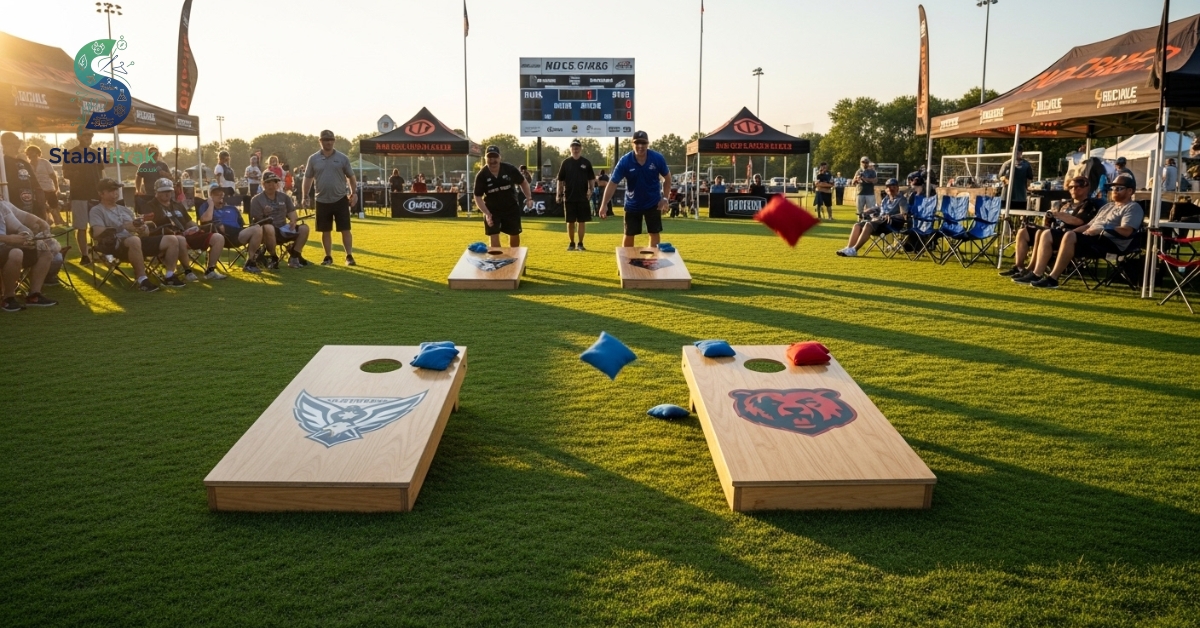
Yes, for casual or junior play, you can reduce the distance. For tournaments, stick to the 27 feet apart standard to meet ACA guidelines.
Regulation Cornhole Board Distance
Official adult spacing: 27 feet front edge to front edge. Junior spacing: 12 to 15 feet. These distances balance challenge and playability.
Exceptions to the Distance Between Boards
- Indoor spaces with limited room
- Poolside or recreational setups
- Beginners learning toss mechanics
Adjust distances, but note these aren’t tournament standard.
Additional Distance Details for Cornhole
- Keep boards in a straight line
- Ensure level ground for both boards
- Leave clearance around courts to avoid collisions
Working up to Regulation Distance
Start with shorter distances, gradually increasing as skill improves. This builds confidence and improves accuracy over time.
Grab Your Custom Cornhole Set Today!
Custom boards and bags allow flexibility in spacing, décor, and playstyle. Whether you stick to regulation distance or try backyard variations, a personalized set improves your experience.
FAQs
How far are cornhole boards supposed to be apart?
Official cornhole boards should be 27 feet apart from front edge to front edge. For kids or beginners, you can adjust to 12–15 feet for easier play.
Do you have to get exactly 21 in bags?
No, the first team to reach 21 points or more wins. If a team exceeds 21, the score may vary depending on the scoring method used.
How do you score in cornhole?
A bag on the board scores 1 point, and a bag in the hole scores 3 points. Points can cancel out the opponent’s bags in a frame.
How far apart do you put bean bags?
Bean bags are thrown toward the boards; distance is determined by the board spacing. Maintain official distances for competitive play.
Cornhole rules
Players alternate tossing four bags each. The goal is to score points by landing bags on the board or in the hole.
Cornhole scoring rules
Use cancellation scoring: points from one team cancel out the opponent’s points. Keep track after each frame.
Cornhole bust rules
If a team exceeds 21 points, they may “bust” and revert to a lower score depending on tournament rules.
Cornhole board dimensions
Boards should be 48 inches long, 24 inches wide, with a 6-inch diameter hole centered 9 inches from the top.
How many bags for Cornhole
Each team uses four bags, typically filled with corn or synthetic pellets, weighing around 14 to 16 ounces.
Cornhole scoring app
Several apps help track scores, frame by frame, including point cancellations, fouls, and totals.
Cornhole rules over 21
Exceeding 21 points may result in a “bust,” depending on official or house rules. Always clarify before competitive play.
Cornhole board leg dimensions
Front legs raise the board 3 to 4 inches, while back legs elevate the board 12 inches to create the proper slope for play.

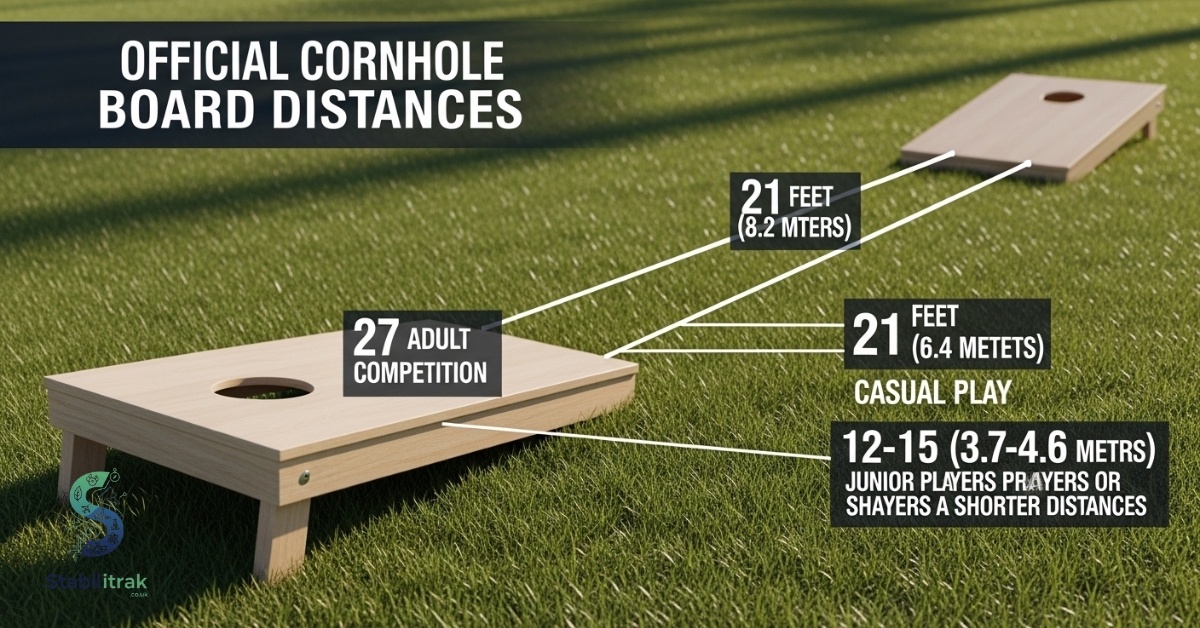
2 thoughts on “Perfect Cornhole Board Distance for Every Game”